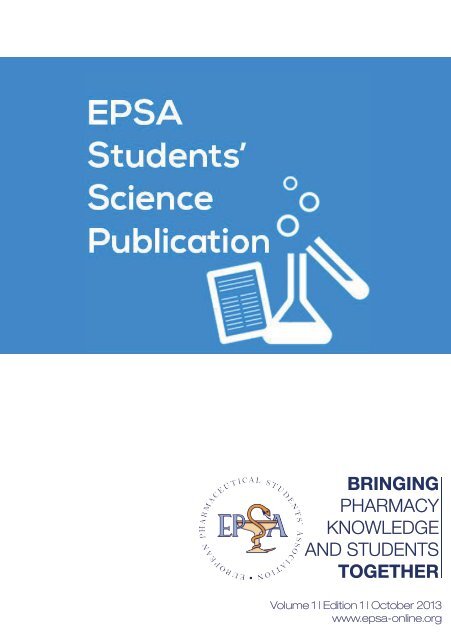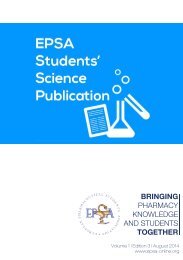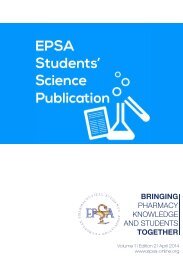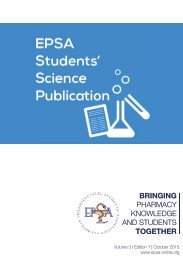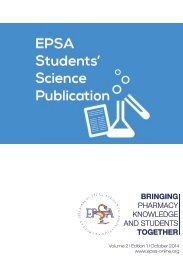essp01
You also want an ePaper? Increase the reach of your titles
YUMPU automatically turns print PDFs into web optimized ePapers that Google loves.
BRINGING<br />
PHARMACY<br />
KNOWLEDGE<br />
AND STUDENTS<br />
TOGETHER<br />
Volume 1 | Edition 1 | October 2013<br />
www.epsa-online.org
EPSA Students' Science Publication<br />
Dear friends,<br />
INTRODUCTION<br />
The purpose of the European Pharmaceutical Students' Association (EPSA)<br />
is to bring pharmacy, knowledge and students together. A way of bringing<br />
students' knowledge together, on a scientific level, is this new project which is<br />
a coalition between two departments: Education and Public Relations.<br />
In other words, Students + Science + Publications = EPSA Students' Science<br />
Publication (ESSP). We are proud to finally be able to collect abstracts of<br />
student research projects and compile them in a publication that students<br />
all over Europe can read and gain inspiration from. Additionally, authors get<br />
the opportunity to share their research, hypothesis, ways of tackling scientific<br />
obstacles, results and thoughts on the outcome of each scientific project. This<br />
publication will also contain some personal comments on the authors’ research<br />
experience alongside the abstracts.<br />
In order to ensure quality in the publication, we have been very lucky to be<br />
assisted by professional holds - with the help from Professor and Head of Drug<br />
Transport and Delivery Research Group, Natsa Skalko-Basnet, Department of<br />
Pharmacy (Dep. Phar) and Associate Professor at the Molecular Pharmacology<br />
Research Group (Dep. Phar), Yury Kiselev, both from the University of Tromsoe,<br />
Norway. We want, once again, to thank both of them for the energy put in this<br />
project and also thank all the students who have submitted their abstracts -<br />
because without them, this journal wouldn't exist!<br />
We hope you enjoy reading this publication, and we hereby invite and encourage<br />
you to send in your abstracts for the next editions!<br />
Yours in EPSA,<br />
Science Coordinator and Publications Coordinator 2013/2014<br />
Rebwar Saleh and Mara Lefter<br />
2
TABLE OF CONTENT<br />
Volume 1 | Edition 1 | October 2013<br />
Determination of nitrogen and organophosphorous pesticide<br />
residues in foods of plant origin – method validation, Srđan<br />
Radak......................................................................................... 4<br />
Figures and tables .......................................................................... 5<br />
Q&A of the authors ......................................................................... 6<br />
Determination of resveratrol in dietary supplements and<br />
assessment of their antioxidant activity, Karolina Podoga and<br />
Aleksandra Polak ...................................................................... 8<br />
Figures and tables .......................................................................... 9<br />
Q&A of the authors ....................................................................... 10<br />
Quantification of polyphenolic compounds with antioxidant<br />
action from various plant species, Carmen Sultan ................. 12<br />
Figures and tables ........................................................................ 13<br />
Q&A of the authors ....................................................................... 14<br />
Afterword ...................................................................................... 15<br />
3
EPSA Students' Science Publication<br />
DETERMINATION OF NITROGEN AND<br />
ORGANOPHOSPHOROUS PESTICIDE RESIDUES<br />
IN FOODS OF PLANT ORIGIN – METHOD<br />
VALIDATION<br />
Radak, Srđan. Medical Faculty, Department of Pharmacy, Novi Sad, Serbia<br />
Combination of QuEChERS method and gas or liquid chromatography with<br />
mass spectrometry has enabled pesticide residue analysis in a wide analytical<br />
range with high selectivity and sensitivity. These analytical tools have become<br />
a mainstay in most laboratories for pesticide monitoring in order to meet global<br />
standards.<br />
The aim of the study consisted in the validation of QuEChERS/GC-MS<br />
method for analysis of selected nitrogen and organophosphorous pesticide<br />
residues and evaluation of measurement uncertainty. The validation study<br />
was conducted on organically grown potato and carrot, fortified with standard<br />
mixture of nitrogen and organophosphorous pesticides, at two concentration<br />
levels, prepared by QuEChERS method and analysed by GC-MS.<br />
The results of the study showed that the limit of quantification for the analytical<br />
method of 10μg/kg reached 63% of target compounds in both examined<br />
matrices, and additional 21% compound in just one. Estimated limit of<br />
quantification of instrumental method was below or at the level of 10μg/kg<br />
for 89% of analytes in both matrices. Matrix-matched calibration curves were<br />
constructed in the range defined by the limit of quantification at lower level<br />
and 500μg/kg as the upper one. At 10μg/kg fortification level, 63% and 76%<br />
of analytes showed acceptable recovery values in potato and carrot matrix,<br />
respectively. At 100μg/kg fortification level, those values were 76% and 74%.<br />
Pesticides with good recovery values were also characterized with good<br />
precision. Evaluation of expanded measurement uncertainty showed that this<br />
parameter was below 50% for all pesticides meeting the validation criteria.<br />
Conclusion: Validation study and evaluation of measurement uncertainty<br />
confirmed the quality of multi residual QuEChERS/GC-MS method for the<br />
analysis of selected nitrogen and organophosphorous pesticides.<br />
4
FIGURES AND TABLES<br />
Volume 1 | Edition 1 | October 2013<br />
5
EPSA Students' Science Publication<br />
Q&A OF THE AUTHORS<br />
1. Why did you select this topic for your research / master thesis?<br />
Analytical chemistry is my favorite field of pharmacy. I have had the<br />
opportunity to use analytical instruments such as high performance liquid<br />
chromatography (HPLC) and gas chromatography (GC) since 2nd year of<br />
studies.<br />
2. How do you feel you have coped with the challenges that research brings?<br />
The topic is quite complex, but I have had a great opportunity to learn and<br />
work with Ass. Prof. Ljilja Torović. She is an expert in this field and one of<br />
the greatest professors in our faculty. I think I just scratched the surface of<br />
analytical chemistry and I am seeking for more knowledge.<br />
3. What personal skills have you developed as a researcher during your<br />
research period?<br />
I learned the importance of correct time management, patience and<br />
hardworking.<br />
4. If you had the opportunities, would you specialize more in the field?<br />
Yes, I have been interested in PhD and I hope to continue doing this type of<br />
research in the future.<br />
5. Any other comments you want to share with other students?<br />
Once again, I would like to thank Ass. Prof. Ljilja Torović for all the help she<br />
provided me during the research.<br />
More information:<br />
srdjanradak@yahoo.com<br />
6
Volume 1 | Edition 1 | October 2013<br />
DETERMINATION OF RESVERATROL IN DIETARY<br />
SUPPLEMENTS AND ASSESSMENT OF THEIR<br />
ANTIOXIDANT ACTIVITY<br />
Podoga, Karolina and Polak, Aleksandra from Nicolaus Copernicus University Collegium<br />
Medicum in Bydgoszcz, Poland<br />
Resveratrol (3,5,4'-trihydroxy-trans-stilbene) is a polyphenolic compound<br />
found in the skin of red grape skins, red wine and Japanese knotweed<br />
(Polygonum cuspidatum). During the last decade, resveratrol became a subject<br />
of many clinical trials, due to its influence on multiple biochemical pathways ,<br />
in particular as a strong antioxidant and chemopreventive agent. Resveratrol<br />
nutritional supplements are available over-the-counter on the pharmaceutical<br />
market and the sales are constantly increasing.<br />
The aim of this study was to optimize chromatographic method for the<br />
determination of resveratrol in food supplements, as well as evaluation of their<br />
antioxidant activity. Dietary supplements used in the project were available<br />
on the Polish pharmaceutical market: one containing only resveratrol (e.g.<br />
Trans Resveratrol) and the other multicomponent supplements (Cellasene,<br />
LongaVit, Natursteron, Nutrof). Determination of resveratrol was performed<br />
using isocratic reversed-phase high performance liquid chromatography (RP-<br />
HPLC) with spectrophotometric detection (306 nm). The antioxidant properties<br />
of tested supplements were evaluated in vitro by determining the efficiency of<br />
the inactivation of the synthetic stable radicals (DPPH •). For each sample the<br />
IC50 value was calculated, which determines the concentration of the sample<br />
causing 50% inhibition of radicals. In the final stage of the experiment, all tested<br />
supplements were compared in terms of the amount of active substance they<br />
contained, and also their antioxidant potential.<br />
Results show that the content of active substance in dietary supplements is<br />
not always the same as declared by the manufacturer. The differences in the<br />
concentration of active substance may have an influence over the expected<br />
effectiveness of dietary supplements. The study shows that preparations have<br />
various antioxidant activities. The strongest antioxidant is the multicomponent<br />
supplement – Nutrof, containing also, besides resveratrol, a number of other<br />
substances with antioxidant activity (selenium, zinc, vitamin C, vitamin E).<br />
Surprisingly, a low IC50 value (high activity) was obtained for Longavit containing<br />
only 390 mg of standardized extract from the black grape skins. This may<br />
be a result of the presence of additional natural polyphenolic compounds in<br />
grape skin extract . Dietary supplement – TransResveratrol – according to the<br />
manufacturer‘s assertion, containing 200 mg pure trans-resveratrol in capsule,<br />
has the lowest antioxidant activity. The real content of trans-resveratrol in 1<br />
capsule is 4-fold less than declared.<br />
7
EPSA Students' Science Publication<br />
FIGURES AND TABLES<br />
Graph 1: Determination of resveratrol antioxidant activity.<br />
Graph 2: Relation/Nexus between radical activity inhibition (%) and the<br />
concentration of dietary supplement - Nutrof.<br />
8
Q&A OF THE AUTHORS<br />
Volume 1 | Edition 1 | October 2013<br />
1. Why did you select this topic for your research / master thesis?<br />
The reason seems to be simple. It is due to the fact that the regulations for<br />
dietary supplements are different and less strict than those for prescription<br />
or over-the-counter drugs. Then, these studies in our opinion become<br />
extremely valuable. Obviously, dietary supplement companies affirm their<br />
products’ efficacy and good quality. The aim of our research was to check<br />
how far the companies’ declarations are from the research results.<br />
2. How do you feel you have coped with the challenges that research brings?<br />
We’ve manage to test some of the dietary supplements which were<br />
available in the Polish Pharmaceutical market. The goal for the future is to<br />
test another part of these products and compare them among each other.<br />
This would allow to choose the best product, containing resveratrol, in the<br />
Pharmaceutical market.<br />
3. What personal skills have you developed as a researcher during your<br />
research period?<br />
The first one would be assiduity, especially when at the beginning of the<br />
research some of our results weren’t reproducible. We have learnt that no<br />
matter how many difficulties will occur on your way, you should follow and<br />
fulfill your passion. The satisfaction at the end is the best prize you could<br />
imagine. The other personal skills that we have managed to obtain during<br />
the whole process of our research were definitely: being more accurate and<br />
focused.<br />
4. If you had the opportunities, would you specialize more in the field?<br />
Yes, of course. If we were given such a chance, we would definitely like to<br />
specialize ourselves in this field of science.<br />
5. Any other comments you want to share with other students?<br />
To all students - If there is something that you are really interested in, do<br />
not waste your time and go for it!<br />
Even if it seems to be impossible<br />
to achieve, don’t give up! Together,<br />
passion and joy for what you are<br />
doing connected with hard work,<br />
are the formula which make dreams<br />
come true!<br />
More information:<br />
karolina.pogoda@gmail.com<br />
9
EPSA Students' Science Publication<br />
QUANTIFICATION OF POLYPHENOLIC<br />
COMPOUNDS WITH ANTIOXIDANT ACTION<br />
FROM VARIOUS PLANT SPECIES<br />
Sultan, Carmen., The university of Carol Davila, Bucharest, Romania<br />
Nowadays many diseases are influenced and some are generated by oxidative<br />
stress which results from free radicals and reactive oxygen species. This is why<br />
research is oriented towards finding a natural solution: vegetable antioxidants.<br />
Poly-phenolic compounds (flavonoids, caffeic acid, chlorogenic acid) from<br />
plants are known to have antioxidant properties so that they may be used in<br />
therapy.<br />
Crataegi fructus, Daucus carota tuber, Aurantii pericarpium and Myrtilli fructus<br />
extract were subject to pharmacognostic analysis and HPLC analysis to<br />
determine the free radical scavenging and antioxidant properties.<br />
In Crataegi and Myrtilli fructus, there were identified poly-phenolic derivatives<br />
(flavonoids, anthocyanins, proanthocyanidins, catechol). In Daucus carota<br />
tuber, there were determined tetraterpenoid compounds such as carotenoids .<br />
Regarding Aurantii pericarpium there were found flavonoids, proanthocyanidins<br />
and catechol. HPLC analysis separated caffeic acid in Crataegi fructus and<br />
Aurantii pericarpium, ferulic acid in Aurantii pericarpium and Myrtilli fructus,<br />
quercetol in Daucus carota tuber and Crataegi fructus.<br />
The analysed plants proved to be an important source of compounds with antiradical<br />
activity thus justifying their use associated with treatment for different<br />
types of ailments (disorders caused by capillary fragility, angiopathy and<br />
diabetic retinopathy, hemeralopia, dermal diseases, cardiovascular disorders).<br />
10
FIGURES AND TABLES<br />
Volume 1 | Edition 1 | October 2013<br />
11
EPSA Students' Science Publication<br />
Q&A OF THE AUTHORS<br />
1. Why did you select this topic for your research/master thesis?<br />
At first I chose the department in which I wanted to do the research and then<br />
decided to work on something that could answer a current issue. With the<br />
help of my coordinating teacher I settled on antioxidants, more specifically<br />
the quantification of antioxidant compounds from 4 different plant species.<br />
2. How do you feel you have coped with the challenges that research brings?<br />
I was very enthusiastic about the research in the beginning and had a lot of<br />
ideas, then got a little less enthusiastic when I realised that not all of them<br />
could be applied. In order to get some results and after a great amount of<br />
work has been done, I had to change my initial plan because the results<br />
didn’t match with the hypothesis. I was really happy in the end when I<br />
realised the achievement.<br />
3. What personal skills have you developed as a researcher during your<br />
research period?<br />
Patience, perseverance, hard work, desire and knowledge.<br />
4. If you had the opportunities, would you specialize more in the field?<br />
Lab work is interesting and rather addictive: after finishing a research you<br />
want to continue with a different aspect of the same topic in order to have a<br />
complete view over the discussed issue. But working in this field only suits<br />
some of us - personally, talking with patients seems more challenging and<br />
fills me with the needed satisfaction.<br />
5. Any other comments you want to share with other students?<br />
Don't hesitate to get involved in research papers during university! It is an<br />
experience that shall contribute to your professional development even<br />
if you decide to take a different career path after graduation. There's no<br />
bigger accomplishment than sending the message across to others that<br />
find your work interesting and want to know more about it.<br />
More information:<br />
marocana14@yahoo.com<br />
12
AFTERWORD<br />
Volume 1 | Edition 1 | October 2013<br />
The idea of this publication was born at the first Team Meeting in Novi Sad,<br />
Serbia where members of the Education Board discussed the possibility of<br />
creating a platform where students can share knowledge. Also, together with<br />
the Vice President of Public Relations (VPPR) Stefan Rack, the idea got more<br />
air under its wings. Later on in the process, the publication coordinator, Mara<br />
Lefter, got involved in the projects in those areas where the project touched<br />
her portfolio.<br />
For this first publication, participants of the 5th EPSA Science day were<br />
called and asked for their interest in sharing their abstracts with the rest of<br />
the members of EPSA that did not have the opportunity to experience their<br />
awesome presentation in Catania, Italy. Luckily, we got enough responses to<br />
launch the project.<br />
They sent in their abstracts and answered those questions that were prepared<br />
beforehand, and our two professional researchers, Prof. Skalko-Basnet and<br />
Ass. Prof. Kiselev, went through all the abstracts in order to ensure its quality.<br />
The authors got the recommendations from the researchers, edited some parts<br />
and it was all was compiled into what you have seen today.<br />
Personally, I would like to grab my opportunity to once again direct a huge<br />
“Thank you” to all bodies involved. From our researchers, to our main involved<br />
VPs, Stefan Rack and Jorge Batista for their support. I would also thank<br />
specifically our Publication and Design coordinators, Mara Lefter and Svenja<br />
Laarhuis, for guiding through the, in my opinion, magical world of “how to<br />
make things look good”. Without their energy and effort, this would look like a<br />
regular word document (Black on white) with lots of text and without that real<br />
spice that they have managed to add.<br />
Now it is time for me to invite all our members students to share their knowledge<br />
and research outcomes. I would like to encourage everyone to send in abstracts<br />
and take part in this project. This is your opportunity to practice your skills in<br />
writing summaries of your research that you may need in your future career.<br />
Also, this is your chance to inspire other students for their future research!<br />
If you are interested, please send an e-mail to science@epsa-online.org and<br />
you will receive a list of requirements for documents that are needed for this<br />
publication!<br />
Yours in EPSA,<br />
Rebwar Saleh<br />
EPSA Science Coordinator 2013/2014<br />
13


